
Paris is an exciting destination, anytime…but in January? If any month could dampen the ardor of my on-going and torrid midlife love affair with Paris, surely January would be it. Our friends Cindy and Gerry offered us use of their wonderfully located Marais apartment, which would otherwise be sitting open and unused, an appalling situation; naturally, I like to do my part.
This is probably the 7th time I have stayed in this central and always stimulating and historic neighborhood. The pedestrian street in the heart of this neighborhood, rue des Rosiers (rosebushes en français), is lined with restaurants and bakeries reflecting the historic and ongoing status of this area as Paris’ Jewish quarter. There are duelling fallafel joints on either side of the street, including the “Toujours imité, jamais egalé” (always imitated, never equaled) standard, L’as de Fallafel. 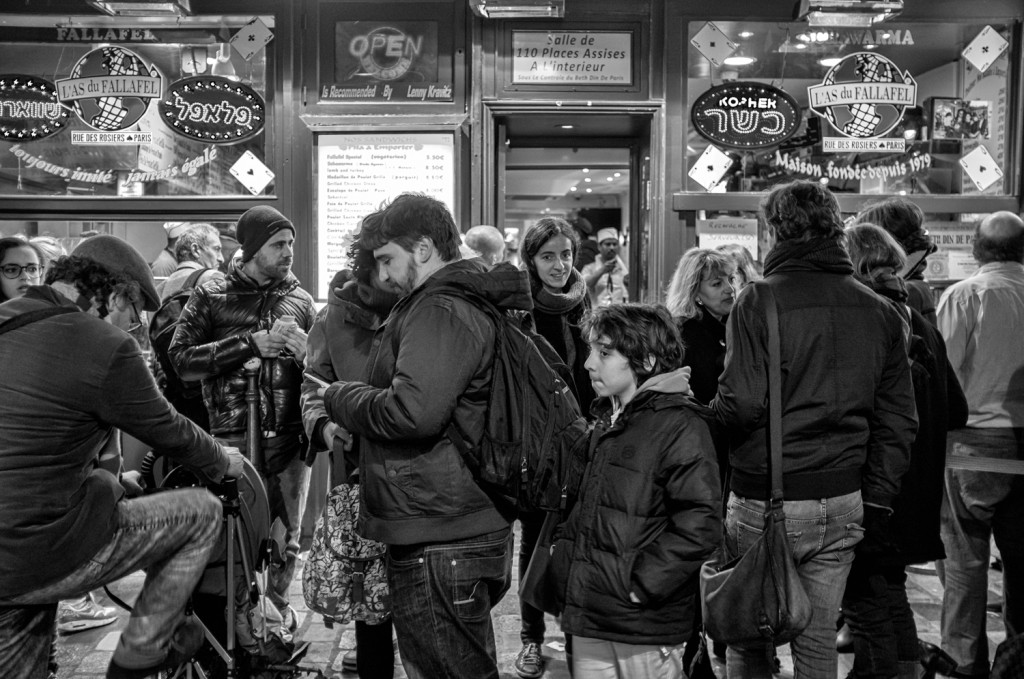
It has become our custom to make a beeline for L’as de Fallafel as soon as we land in town, assuming it isn’t Saturday, when they are closed for the Jewish Sabbath. I had read that the across the street rival, Mi-Va-Mi, was “nearly as good.” But nearly as good really isn’t as good, is it? I broke down on a Saturday on a prior trip and sampled the competing offering and decided it really is worth waiting until L’as de Fallafel is open. Even if the line is down the block and yes, even if it is cold outside. They don’t call it the Ace for nothing.
It didn’t disappoint. The fallafel (or schwarma, which is another favorite) is topped with delicious and colorful ingredients, including shredded zucchini and red cabbage, roasted eggplant, chopped tomatoes, and tahini, bulging the pita , threatening one’s clothes. This requires a careful balancing act, especially if taken away from the walk-up window. It wasn’t around in Hemingway’s time, but is a contender for a possible interpretation for “A Moveable Feast.”
Of course, that is how we spend much of our time in Paris, moving from patisserie to bar à vin, to restaurants, to chocolaterie, feasting as we go.
I reread “A Moveable Feast” recently, after reading a counterpart tale, “The Paris Wife,” a fictionalized account of Hemingway’s early years in Paris, written from the point of view of his first wife, Hadley. Both accounts indicate that the Hemingways were quite empoverished in their early years in Paris, the period Hemingway recalls in this collection of short sketches, so clearly my interpretation isn’t what Hemingway intended. Probably closer to his intention is that one can enjoy Paris in many different and unique ways, at all levels. This has certainly been my experience, from my first few days as an impoverished freshly minted college graduate, soon to be an even poorer and indebted medical student, in 1982. The wonder of my first step in a Parisian patisserie is still with me, even as I’ve gradually become better able to afford the offerings. I would still wail (as I did back then) if I witnessed one of these beautiful desserts crash to the concrete, but at least I no longer would consider such an event financially disastrous, merely tragic.
My experience of Paris has also been enriched over recent years by learning French-oui, oui, quelle idée! This started exactly 5 years ago. Now I am reasonably comfortable negotiating most situations in French, but even 30+ years ago, knowing less than 10 words of French, I always had a great time in Paris. Even though one can easily navigate around Paris and thoroughly enjoy it without any knowledge of French, there is no question that the more French one knows, the richer the experience. Being able to converse with people in their native tongue is priceless, not to mention being able to decipher the clever store names and in jokes on signs and posters.
Jetlag is the enemy early on, so the best antidote is to keep moving. We started off early our first morning, motivated by it being the last day to catch a joint Frida Kahlo-Diego Rivera show, L’art en fusion, at Musee de L’Orangerie. We recently saw Frida’s family home, La Casa Azul, and her shared home and studio with Diego (Casa Estudio) in Mexico City, as well as a mildly “controversial” show of reproductions of all of Frida’s paintings in San Diego, The Complete Frida. My friend Patricia, a retired healthcare IT consultant, volunteered to get one of us in with her pass, and we knew it would be crowded being the last day, so no help for it: an early start. Indeed, as we walked up through the Tuileries, a healthy line had already formed at 8:45 am, well before the 9 am opening, and even before the stanchions had been put out to organize the expectant crowd.
Although we had plenty of company as expected, it was wonderful to see these paintings, many from the collection of Museo Dolores Olmedo, near Mexico City. She was a friend and admirer of Diego’s who built one of the largest collections of his work, 137 examples, as well as 25 paintings of Frida’s acquired on his advice (a high percentage of her output of 143 paintings). We had not had time on our recent Mexico City trip to visit this museum; indeed, judging by the work from this museum on display here, probably visiting in November would have been disappointingly thin, with so many key pieces on loan.
As the crowd for the Kahlo-Rivera show swelled, we took refuge for a few minutes in the lovely oval galleries upstairs housing Monet’s later life masterworks, the huge, amorphous, nearly abstract water lily series, the Nymphéas.
A short walk away, we were off to the Grand Palais, for a photography show of Raymond Depardon, a French photojournalist whose less well known, vibrant color work from around the world, was being highlighted in this show.
As we were considering options for lunch in the first arrondissement, we passed a branch of Jean-Paul Hevin chocolatier, the only one with a salon du thé. Patricia endorsed the chocolates, as well as the chocolat chaud. Although we hadn’t reserved, there were 3 places at the counter with our names on them. My risotto with broccoli, Patricia’s fish quenelles and Steve’s chicken curry and rice were nicely prepared and satisfying, leaving us just enough room to share un chocolat chaud (dark, delicious, not too sweet version!) and a gateau du chocolat called “Guayaquil.”
From there, Patricia walked us over to a wine tasting we had scheduled at Ô Chateau, by way of the Palais Royale, where a giant bubble blower held court by one of my favorite metro entrances, the Kiosque des Noctambules. This canopy of glass “bubbles” was designed in 2000 by French artist Jean-Michel Othoniel to celebrate the new Millennium. 
On the way, a tiny Japanese antique dealer’s window filled with tiny and intricately carved netsuke lured us in. Netsuke are miniature sculptures, carved from ivory or wood, to help suspend a small purse-like box or pocket from the obi (belt-like sash) securing a kimono. There was even a netsuke with amber colored (if not amber) eyed rabbits, one of the more expensive of those on offer, at 1500 Euros. The owner was also half-Japanese, and we enjoyed hearing more about these rare collectables from this clearly knowledgeable enthusiast. The book “The Hare with the Amber Eyes” which my book club read a year or so ago has undoubtedly raised the world’s awareness of these tiny and precious collectibles.
The tasting, led by Joe, was really entertaining and informative. Called the Tour de France of wine, we learned a lot for people who have spent a far amount of time in France, imbibing les vins with some regularity. He did a great job reviewing the basic chemistry behind champagne production, namely the conversion of sugar in grape juice into alcohol through yeast-mediated fermentation, producing a white wine, which then undergoes a second fermentation when additional yeast and sugar are introduced into the bottle. He encouraged us to explore “cremant” wines produced outside of the official champagne region for potential good values, including those from lesser known regions such as Jura.
Our walk home led us to the foodie street, rue Montorgueil, where we happily stocked up on provisions, pâté from Stohrer, bread from Eric Kayser, mimolette (now banned in the US-waah!) from le fromagerie. 
The next morning, we had planned to beat the crowd at the Hotel de Ville for the Brassaï, Pour L’Amour de Paris exhibit, by being there in time for the 10 am opening. We didn’t quite make it, but the line outside in the drizzle wasn’t grand choses. This free city owned venue offers consistently interesting shows. Steve and I had loved a show on the life of Gustave Eiffel on a prior visit and Patricia and I braved the fashion-mad throngs for a terrific haute couture show on my last visit. Brassaï is one of those photographers whose black and white images of Paris are iconic, especially his nighttime scenes of Paris in the fog.
We headed to Verjus for lunch, based on my friend Margie’s reports of her husband Michael “moaning” through his Bakesale Betty fried chicken sandwich on their last visit. We shared one, with a shaved brussel sprout salad, which was scruptious as well.
In the afternoon, we went to the nearby Jeu de Paume, based more on proximity than on knowing anything about the featured photographer, Erwin Blumenfeld. He was a mid-20th century portrait and fashion photographer who was chased by WW II to the US, where he had a thriving career working for the big fashion magazines during the 50s and 60s. We both had a simultaneous jetlag spell halfway through the show, which responded successfully to coffee in the cafe.
We did perk up for the gastronomia of Spring, a celebrated restaurant helmed by American Daniel Rose, that I have wanted to try for years. The menu is fixed and we elected the wine pairing as well (85 E per person, 60 E wine pairing, including champagne aperitif, 2 verres de vin blanc, un verre de vin rouge et un verre de vin dessert (Montbazillac). We started with oysters; a chicken, fois gras and celeriac roll; and a Jerusalum artichoke soup. The main courses were a fish, hake with chervil and capers, and lamb (with additional “parts”, including kidneys, abdominal wall, feet and pancreas served in a small pan on the side, the perfect way for the more timid to try organ meats without too much committment ). Dessert was a baba rhum. For me, it was the gastronomic highlight of this trip, flawless, no missteps, beautifully presented, albeit not inexpensive.
Wednesday we had to face up to the realization that Steve’s “allergy” symptoms were actually a cold. So, off to the local pharmacist we trotted. Medically compensated, we headed south for the day, into new territory for us. First stop, the catacombs. We had actually been scheduled to visit the catacombs years back with Paris Walks, an English language walking tour group that always delivers an entertaining and high value introduction to sections of the city. We’ve enjoyed many of their 2 hour walking tours over the years. One of the few we never managed to do was the Catacombs. A few weeks before we were scheduled with them to see it, the Catacombs were vandalized and closed for an extended period.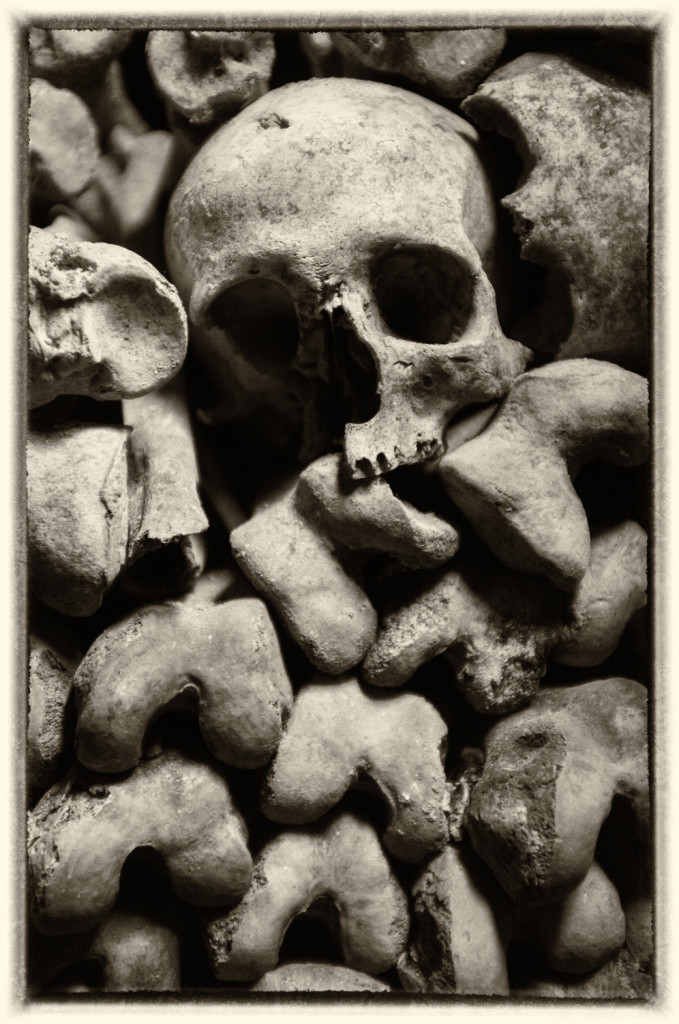
The Catacombs is an ossuary, a repository for the bones of 6 million Parisians from over the centuries, relocated from cemeteries and church graveyards all over the city, beginning in 1786 and continuing until 1860. This was prompted by the closure for sanitary reasons of Paris’ largest cemetery, located in the Les Halles area, in 1780. A few years before, the quarries department had been charged with shoring up the underground network of quarries, which had developed areas of subsidence, sending Parisians into a panic. This department also organized the transfer and storage of bones displaced from Paris’ cemeteries. Essentially, all of Paris is built of limestone, which was quarried locally. There is a vast network of tunnels below grade, which make Paris what it is today, housing the subway, RER trains, the sewer system and the Catacombs.
It is strange to think of the Catacombs being a tourist destination, but it has had this status for 2 centuries, with heads of state (Francis I of Austria in 1814, as an example) being among the visitors over the years. At first, the bones were thrown in a heap in vacant tunnels, but beginning in 1810, the Inspector General of Quarries de Thury prescribed the orderly presentation seen today, presumably leading to the Catacombs becoming a site to visit. It is a cool and dark destination, not for the claustrophobic, vertiginous or unsteady of knee. Access requires descending a long, narrow spiral flight of stairs for what seems like forever ( 20 meters, about 60 feet, or equivalent of 6 flights of stairs). Long, dark, low-ceilinged narrow corridors lead to the ossuary which is signed with these ominous words:
“Arrête, c’est ici l’empire de la mort.” (Stop, this is the empire of the dead.)
The sight of corridors lined with stacked long bones, punctuated with skulls, brought most of the typical tourist babble to a halt, at least for a while. It was remarkably quiet down there, with long stretches of being unusually solitary, especially for Paris. It is hard to express how impressive and sobering a sight these collective remains are. It was an interesting counterpart to our recent experience of Dia de los Muertos in Mexico, which was more celebratory than sad, while this really made one feel the weight of collective human history.
Just down the street was another new destination for us, Fondation Cartier pour l’Art Contemporain, showing another photography show. Some years before, I had really enjoyed the Jean Nouvel design of the Institut du Monde Arabe, and so had been wanting to see his glass-clad design for this art space. There seems to be a wealth of photography shows in Paris in January. Paris Photo is always in November (we went a few years ago with MOPA), and I suspect many of these shows were mounted to coincide with November as the yearly month of photography in Paris, and most had not yet closed. Across the street was a long wall plastered with large open mouths, which proved to be a part of the exhibit we were heading to see. This work is entitled Bocanada, by Graciela Sacco, an Argentinian artist, who has staged such “interferencias urbanas” in other cities, with the open mouths perhaps signifying protests or needs.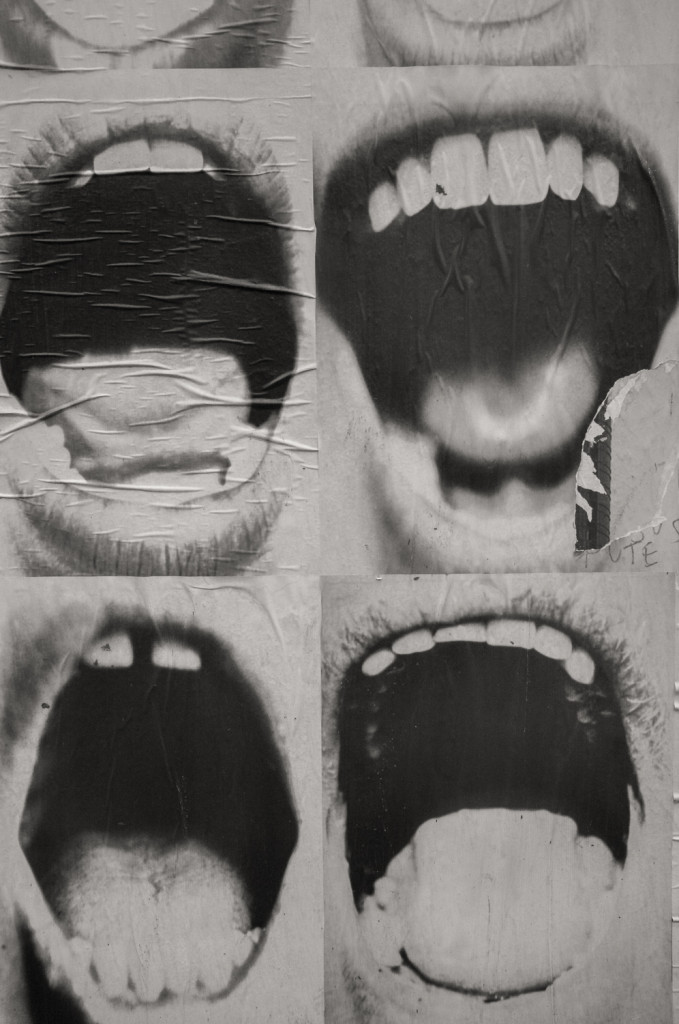
Perhaps coincidentally, perhaps not, there was this bit of street art nearby, which I liked as well: I am a wise woman.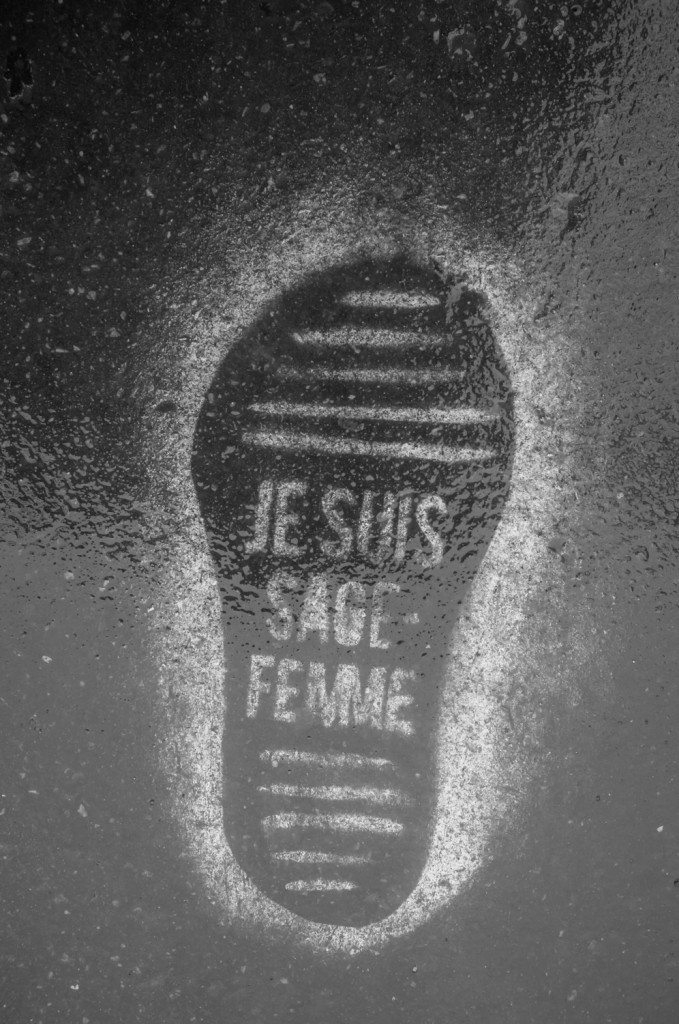
The exhibit, America Latina, 1960-2013, was a pan Latin America show of photography, including a couple of familiar names, photographers we met on our recent trip to Mexico City, including Pablo Lopez Luz and Graciela Iturbide. Pablo was represented by architectural photographs of houses and buildings utilizing concentric triangular and rectangular grid designs in their encircling metal fences and gates (not dissimilar to the pattern used on our hospital, Scripps Green). Pablo traces this to the stepped pattern of Mayan temples and historical sites, making the case that this practice is an expression of identity with pre-Colombian history.
Graciela Iturbide was represented by images from La Casa Azul of Frida’s Kahlo’s personal possessions, from the series Frida’s Bathroom. After the house was left by Diego to the state to become a museum, certain personal effects (Frida’s back brace corsets) were excluded from public view. I remember Graciela recalling being asked by the foundation to go to Casa Azul to photograph them, so it seemed full circle to see images from this series here.
Since we were on the left bank and intending to go see a film, we headed to a perenniel favorite, Le Comptoir, de Yves Camdeborde. The bistrot was already closed, but it was early enough we could easily find standing spots next door at L’Avant Comptoir. The day’s offerings are written on the ardoises as well as suspended on tags from the ceiling. It was delicious, and perfect for a light early dinner, sharing lentils and pork, grilled piments, scallops skewered by rosemary with pesto, a savory waffle with proscuitto (60 E for two including 2 glasses of wine).
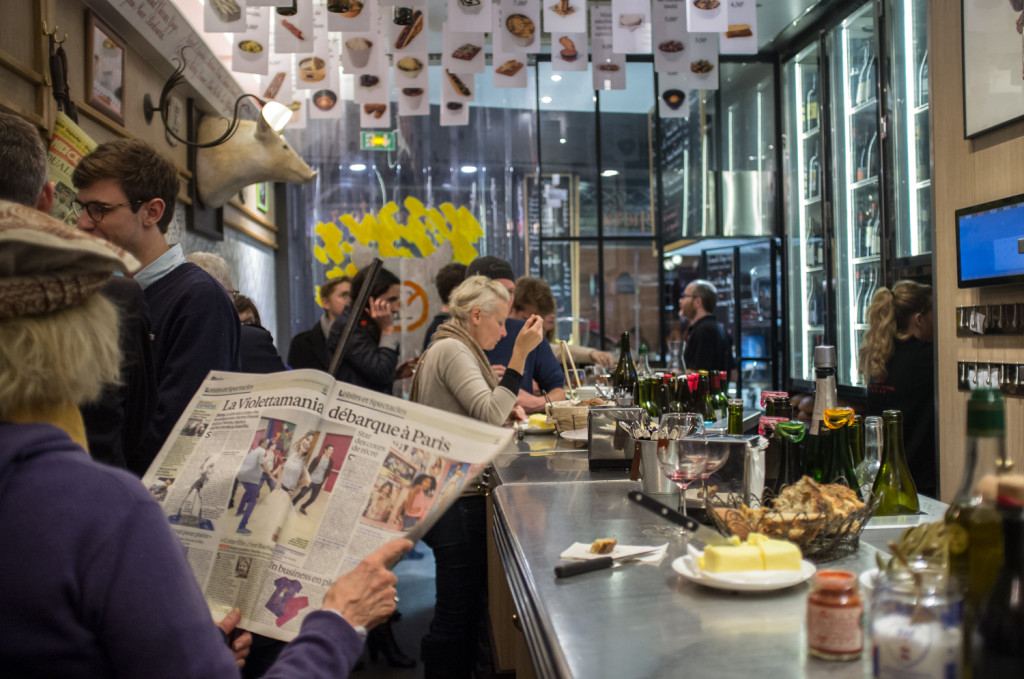
For a few minutes, there was just enough room at L’Avant Comptoir for this purple clad patron to open a newspaper. The headline reads “Violettamania” lands in Paris!
We love Paris as a cinemaphile’s city, with an amazing variety of films on offer at all times, in theaters great and small, vintage and high tech. We knew the tiny theater on rue Christine, Action Christine, from a prior stay at wonderful Relais Christine across the street. This week there was a Fritz Lang film festival on, with one of his films playing in one of their salles each day. The evening’s offering “Moonfleet” was silly, fun, a period comedic drama, certainly no rival to his early acknowledged black and white masterpieces, Metropolis and M.
Thursday is one of the two mornings the Richard Lenoir market is open (we arrived too late for the other, on Sunday), so like a herd of turtles we made a slow start in the morning to forage. Steve likes to cook at least once a trip, especially when we have a kitchen and there is no excuse (except the presence of hundreds of great restaurants to try), so forage we did, for 4 varieties of mushrooms, lemons, shallots and parsley to make his cooking-in-an-unfamiliar-kitchen go-to mushroom pasta recipe, which is delicious. Although we foolishly elected to leave the rolling French market cart at home, we were not too weighed down on the return to not be able to stop at a local bakery favorite, Gerald Mulot, off the Place de Voges. Once Steve was plied with coffee, he agreed to stop into NorieM across the street, a shop filled with interesting clothing designs by Japanese designers, plastered as all the stores are at this time of year with “SOLDES” (SALE) signs.
Yes, the other big argument for January in Paris, besides fewer tourists to share it with, are the twice annual sales in January and July. At NorieM, virtually everything in the store but a few handbags was on sale. I found a few treasures (a pleated short sleeved kimono-style jacket and a felt hat) at a steep discount.
Jetlag came calling in the afternoon, making it a struggle to completely enjoy the beautifully designed and lit “Surrealism et l’objet” show at the Pompidou.
The sculptural work of “classical” surrealists, such as Duchamp and Man Ray, was presented with the work of contemporary artists whose work they influenced, such as Ed Ruscha, Alexander Calder and Cindy Sherman. I especially enjoyed the final room, filled with Joan Miro’s primary colored sculptures, set against contrasting boldly painted walls and highlighted by the late afternoon, almost horizontal sun.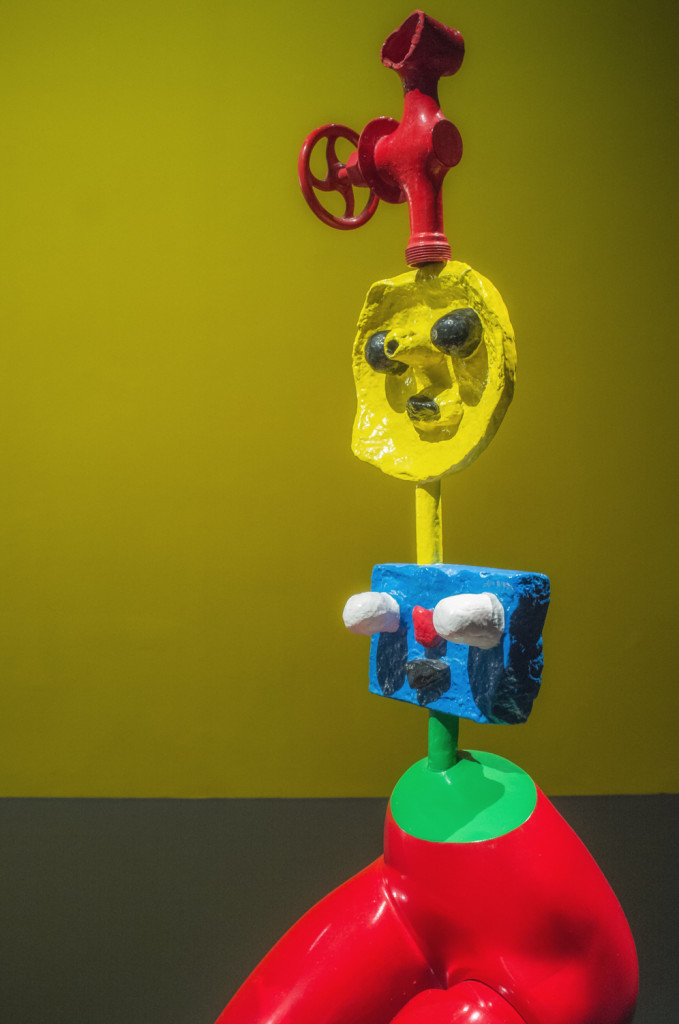
Dinner was in the dining room at Le Comptoir, a reservation I have never been able to get on my own. Thanks to Jane, one of my two “consultants” on the advisibility of going to Paris in January (Jane and Mark have been coming to Paris in January for years), we were scheduled to dine there with them. This is a definite perk of staying at the hotel! Jane said she had tried for 3 years running to reserve there for dinner with no success until they began staying in the hotel. The 5 course menu is fixed at 60 E, with some more expensive options available for an upcharge. The meal was excellent, from the soft egg, brussel sprout and kumquat starter, to the Normand scallops in the shell with yuzu, to the braised and roasted veal with pureed celery root, salsify and chestnut main course. We finished with a cheese platter and a chocolate dessert with mint sorbet.
Friday was an action packed triple exhibit day with Patricia.
For the first time all week, rain seemed unlikely and there were blue skies and some sun (at least intermittently). We started at another new venue for us, the Mona Bismarck American Center for art and culture, on the riverfront across from the Eiffel Tower.
This is housed in a beautiful mansion, and was a lovely setting for the gorgeous black and white portraiture of Armenian photographer Yousef Karsh. The show’s title, Icons of the Twentieth Century was very appropriate: not only were the subjects notables of world literature (Tennesee Williams), cinema (Grace Kelly), arts (Picasso), and politics, in many cases the images captured by Karsh were among the most iconic of these frequently photographed celebrities (Ernest Hemingway).
Just a short walk away was Tokyo Eat, inside of the Palais de Tokyo, a raw industrial feeling space. Steve and Patricia elected the plat de jour (lasagna with spinach and salmon), while I had a nice salad with avocados and grapefruit, as well as great sardines, bread and that delicious Normandie butter.
Next door was the newly refurbished Musée Galliera, the fashion museum, which was showcasing the astonishingly imaginative and body-hugging dresses of Alaïa, the Algerian designer, using leather and other materials in game-changing ways. One of the show stoppers was a jacket featuring a crocodile tail (imagine a short-waisted set of tails with an entire actual crocodile’s tale incorporated into the back).
Our final stop was just around the corner, so close we actually whipped by it before realizing our mistake a few blocks north. The Fondation Pierre Bergé-Yves Saint Laurent is a small space where we saw a David Hockey show on Ipads we really liked a couple of years back. The draw this time was Accelerated Buddha, by the always interesting Japanese photographer Hiroshi Sugimoto. We had no idea what to expect from this title. What we found was a jewel-like room of Asian scrolls and other small, gorgeous pieces (ceramics and one of his crystal pagodas with an imbedded seascape, like we had seen in Marfa a few years ago), leading to a room with large black and white photographs of multiple Buddhas. They were taken in a temple in Kyoto, Sanjûsangendô, which we have visited before. It is known for being filled with Buddha statues, 1000 to be precise, and dates from the 13th century. These same large scale photos form the basis of a video work, in which one is surrounded on 3 sides by giant projections of these same photos. They were alternated with other versions, slightly offset in position. The alternation sped up gradually, faster and faster, to the point the Buddha figures appeared to be running, eventually going so fast, they blurred into a network of oblivion. Evidently, this was a metaphor for the cycle of life and death, creation and destruction. I found it visually quite fascinating, but Steve was less enthralled.
When we parted ways with Pat, we headed to the Seine to the Bateaux Mouches landing, where we had spied a shining silver colored T. Rex dinosaur sculpture earlier. We couldn’t get close enough for a decent shot without buying a ticket for a ride, so that’s what we did. 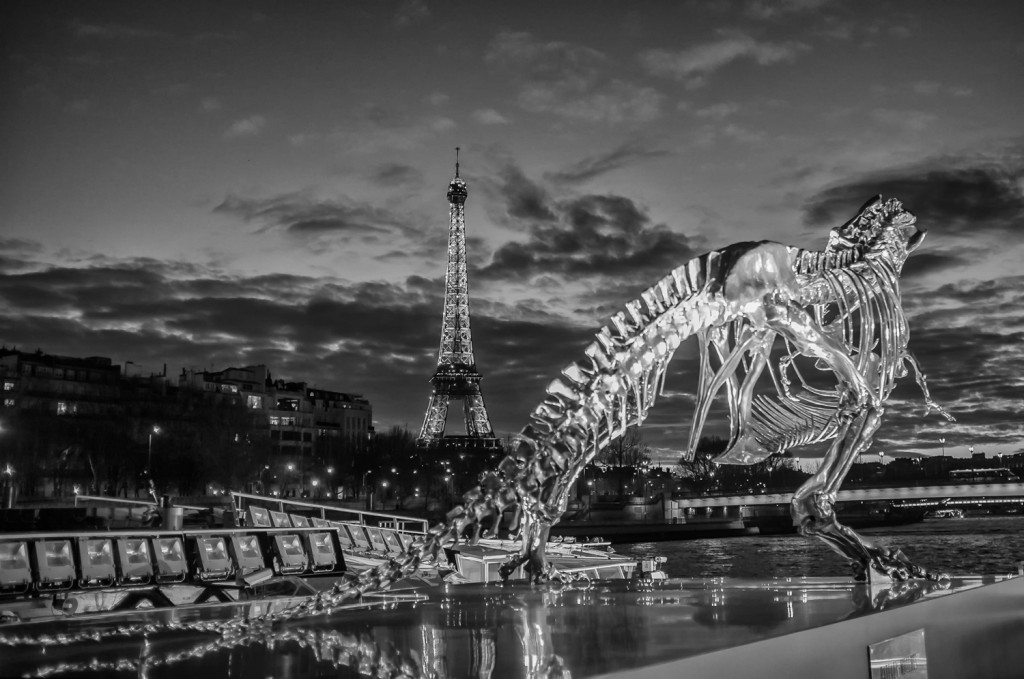 It’s always fun, seeing the lights of Paris from the Seine, as well as the undersides of the bridges and people hanging out by the riverside.
It’s always fun, seeing the lights of Paris from the Seine, as well as the undersides of the bridges and people hanging out by the riverside.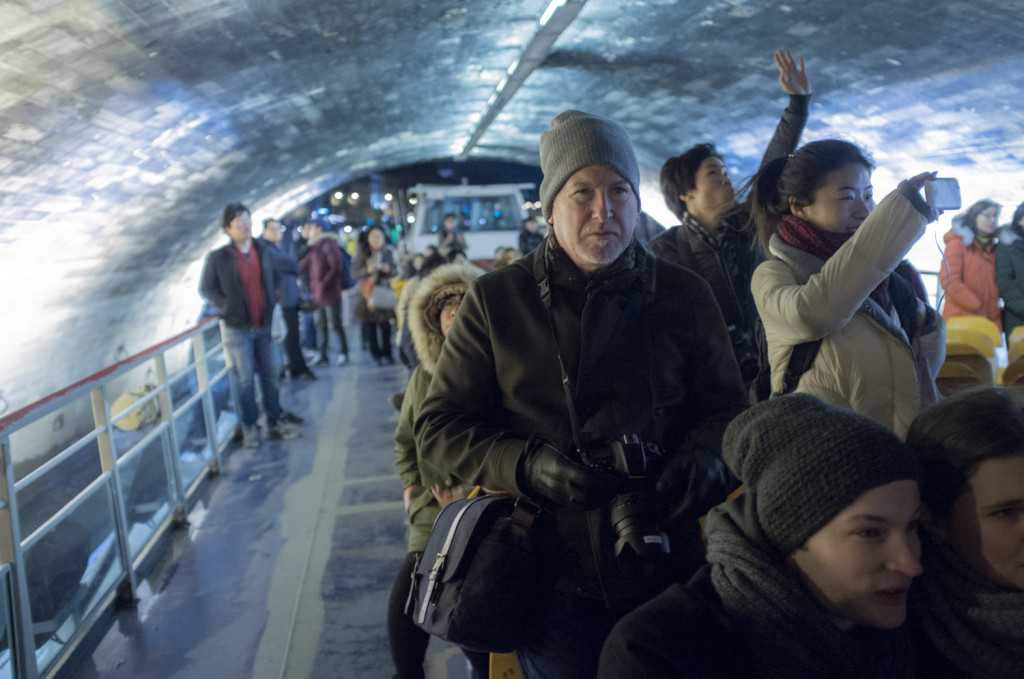
We had to hoof it to make dinner at Verjus in time. Margie (my other “consultant” friend who is a “January in Paris” regular) had mentioned to me that she and Micheal had lunch there in November, and the proprieter Laura had mentioned the possibility of doing a communal “Hidden Kitchen” type meal in their 3rd floor dining room. Before opening Verjus wine bar and restaurant in the 1st arrondissement, Laura and chef Braden offered an occasional multi-course wine-paired dinner out of their lovely apartment. Steve and I had enjoyed some nice meals and company there, punctuated by the surprise of not knowing who or what type of other people might be there. Jane and Mark and Steve and I were joined by 2 women from the US, friends since 4th grade, and a young couple in town for the weekend from London. It was a very nice meal, 6 courses, with 5 tastes of wine, in a pleasant, private and quiet room. The Galicean clams in a harissa enlivened Jerusalum artichoke soup was a highlight, as well as the Mont St Michel scallop and citrus starter. Only one course wasn’t dead on, the wild boar confit marred by a touch too much salt. Everything else was stunning, from the pumpkin and buffalo milk stuffed pasta with nettle pesto and pickled pumpkin, to the duck with smoked celery root and sauerkraut. The wines were enjoyable as well, from the sparkling rosé ( crémant is the term for non-Champagne French champagne method wines, as we learned from Joe at Ô Chateau earlier in the week) from Jura (Domaine Labet), to the red Sancerre (Domaine Vacheron, 2012) served with the mains. All in all, a very pleasant evening (60 E for the 6 course plus amuse-bouche tasting menu and 40E for the wine pairing).
The neighborhood noise and activity level increases on Saturday night in the Marais, especially at nighttime. We were beat by the time we made it home in the evening, glad to have a quiet meal in the apartment. Our day started scooping out a lead on an interesting looking shoe store nearby, Zoe Lee, sent to me by Margie. Even though it was nearly noon, there were no signs of life so we (OK, I) reluctantly moved on to Place de Voges, for a “breakfast” picnic of cherry cloufuti from Gerard Mulot, possibly the best breakfast known to man. Next we tried a box lunch from a next door empanadas place (Clasico-Argentino), one of several locations, but were disappointed. Not bad, just not destination empanadas.
From there, we headed to the Left Bank, for a Paris Walks walking tour of sites associated with the French Revolution. Among other facts, we learned that our terms for political affiliations (left vs. right) date from the French Revolution, with those associated with the revolutionaries sitting to the left of the President of the National Assembly and nobles and supporters of the King seated to the right.
We started on a pedestrian passage, le Cour du Commerce Saint-André, where Danton once lived and giving back door access to Café Procope, a favorite haunt for revolutionary planners. Our guide, Chris, did a nice job describing the convergence of factors leading up to the Revolution, including the King (Louis XVI) being both an absolutist monarch and indecisive, governmental financial straits in the aftermath of having financed the American Revolution, a poor harvest in 1788 due to a hail storm (itself thought to have been precipitated by a volcanic eruption in Iceland several years earlier, affecting the weather), as well as Enlightenment ideals gaining ground. By his description, the Revolution evolved in a swirl of progressive denunciations (anyone could accuse another of being anti-Revolutionary, or just not Revolutionary enough), culminating in Danton being toppled by Robespierre, and Robespierre being executed after presiding over “The Reign of Terror.”
There was just enough time after the tour to make our way over to the Musée National du Moyen Âge, formerly known as the Cluny Museum, best known for La Dame à Licorne tapestries. Yes, first time, stimulated by our visit to the Cloisters in NY in December and finally seeing that spectacular Medieval tapestry series depicting a hunt for the mythical unicorn. This series of tapestries is fantastic as well, and newly restored, so perhaps that worked out just fine to delay until now seeing them. These six wonderfully intricate and colorful tapestries depict a noblewoman and her female companion, gloriously attired and bejeweled, flanked by standard bearing lion and a unicorn.
Five are widely regarded as representing the five senses, while the sixth is perhaps a love tribute on the occasion of a wedding in the family who commissioned these works.
I also enjoyed seeing examples of stained glass at eye level, where one can really appreciate the artistry. 
After being on our feet non-stop for hours, Steve and I were just able to hobble back across to the Right Bank and the apartment, gathering our final provisions for the evening’s meal on the way, happy to have only one course for dinner for a change, but most happy to be off our feet.
Sunday in the Marais is a hotbed of activity, with families and couples out for lunch and walking everywhere. Many markets are closed in other parts of the city, so the population swells in the pedestrian areas of Paris.
We started our day at a leisurely hour with an early lunch (my yearly fix), Breizh Cafe, known for their galettes (buckwheat crepes), oysters and artisanal cider selections, all specialties of Brittany. It was delicious as always. I selected one of the day’s specials, Campagnarde, with smoked duck, mushrooms and Jeruselum artichokes. Sadly, we didn’t have enough room for one of their dessert crepes, definitely poor planning on our part.
We met Patricia at MEP, Maison Européenne de la Photographie, also in the Marais and consistently interesting. It is rare that we come to Paris and don’t go there. This day was no exception, with 2 shows of interest. One grabbed our attention right away, a name that immediately summons macabre associations, namely David Lynch. Yes, the Twin Peaks creator and director of such films as Eraserhead (which despite being a hardcore cinephile, has a strangely hynotic effect on me, making me fall asleep each time I watch it, at exactly the same spot), Blue Velvet, Mulholland Drive, and other moody and surreal visions. This show of black and white photographs, created for this exhibit, is immediately recognizable for it’s Lynchian sensibility, with arresting but disturbing imagery.
The second show occupied multiple floors and was a new name for us, but a wonderful discovery: Joan Fontcuberta, a pluri-potential Catalan artist. Entitled “Camouflages,” the exhibit featured multiple different bodies of work, of astonishing variety, in which he plays with the putative truth perceived in photography. He assumes various identities, constructs whole histories of “scientists,” cosmonauts and other figures, building entire narratives around these types, supported by elaborate documents, specimens, photographs, video, and ephemera. One of my favorites was based on the typological botanical work of Karl Blossfeldt, whose botanical photographs published in 1929 became an overnight sensation and are still regarded as a seminal book of photography. Fontcuberta did his own typology, which at first glance bears a resemblance to Blossfeldt’s work, but closer inspection shows us these plants are deformed, dead, imaginary and quite inventive. In other bodies of work, the artist assumes other personas, including a “scientist” whose “discoveries” are documented by extensive materials, including “specimen” sculptures, sketches, notebooks, descriptions of morphology and other scientific “observations.” Some of the animal “discoveries” of this purported person were quite marvelous and inventive, frankly amusing, such as a snake with multiple pairs of chicken legs.
The light was marvelous when we left, and the length of the line waiting to enter MEP surprising (there had been none when we entered). We enjoyed shooting, that is photographing, children on the carousel near the Saint Paul metro stop.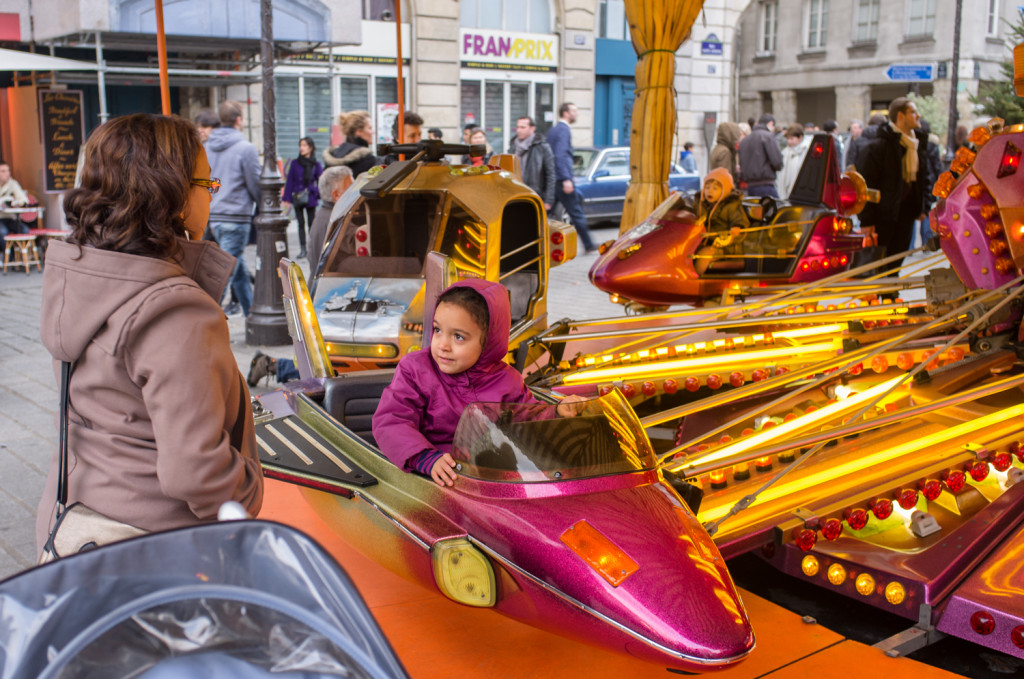
Steve stayed on for more while Patricia accompanied me on my way to shoe nirvana, namely Zoe Lee (another hafu, half-Japanese), also in the Marais. Margie had sent me a link from home, with instructions to check it out! I take these type of responsibilities very seriously. We had actually stopped by the day before, apparently a little too early before their noon opening. Hearing that Zoe Lee formerly worked at Manolo Blahnik before recently launching her own line, and having seen both sensible heel heights and the SOLDE sign (-40%) in the window the day before, I was all over it.
Three gorgeous pairs later, there was just time to drop them off at the apartment before heading over to un apero chez Danielle et Ralph, friends and neighbors of Cindy and Gerry. I had briefly met Ralph before, the first time 5 years before, back when my French was minimal and halting, to say the least. Suffice to say, Steve and I were separated in the metro, and I ended up without a key, little money, no credit card and no phone. I made my way back to the apartment, and stuttered through talking my way into the building with Ralph via intercom:
“Je…suis…une..amie de Cindy…”
Eventually, Ralph couldn’t take it any more, and said in perfect American English:
“You can speak English with me.”
I had a nice task, namely delivering a present to Danièle from the owners of the apartment in which Cindy and Gerry have a share. Knowing she is a Japanophile, I had suggested a beautiful Japanese Farm Food cookbook by Nancy Singleton Hachisu, with which Danièle seemed genuinely enthralled. We enjoyed a most pleasant soirée chez Ralph and Danièle, including a delicious tarte aux pommes, fait à main (homemade by Danièle).
Mondays in Paris, like New York, require a bit of planning, as many museums and restaurants are closed on Mondays. We decided to head north to see a film at a recently restored Eqyptian art deco theatre, Palais du Louxor.
We met Patricia there at noon, not realizing the first showing of Philomena was at 2 pm. Pas de probleme, we strolled around nearby Montmartre, finding all kinds of foodie destinations on rue des Martyrs. The minimal misty rainfall was no deterrent to enjoying a terrific latte under an awning sheltered terrace at a nice Australian cafe, KB Cafeshop (for Kooka Boora).
We all loved the film, and the gorgeous restored theatre, which has 3 salles, a bar and small rooftop deck.
Afterwards, Steve and I walked slowly downhill to Ô Chateau in the first arrondissement. We had so enjoyed the wine tasting the prior week that we had signed up for a follow-up tasting, called “off the beaten tracks.”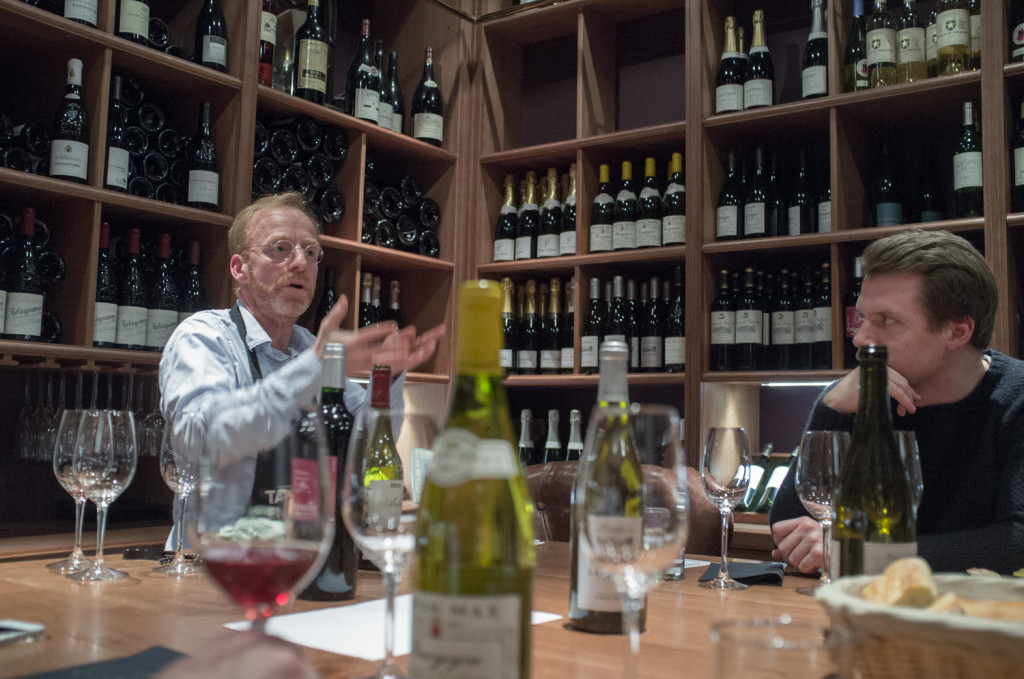 Daniel from New Orleans, a 20 year resident of Paris, led this session, which was indeed interesting and varied, including a white from a little known appellation, Fiefs Vendéens. This is a sandy island off the West coast of France, north of Bordeaux near the Loire, where vines growing in sand were among the few to survive the scurge of Phyloxera which decimated French vineyards in the 1860s. We so enjoyed the 2010 Domaine Saint Nicolas (Les Clous) by Thierry Michon, an intriguing blend of Chardonnay, Chenin Blanc and 10% Grolleau Gris, that we ordered several bottles to lug home. We learned that bio-dynamic wines, in addition to being organic in the ways we would expect (not using pesticides) also means that the grape harvesting and other tasks of cultivation are done by hand and not by machine. Our next white was also delicious, a dry white Jurançon, from the southwest of France, a region known for it’s sweet wines. Of the reds, we especially liked a VDP (vin de pays, or a non-appellation wine) from Languedoc, also from the south. This 2011 wine, Le Pigonnier, is made from 100% Carignan grapes. The use of only Carignan grapes is a choice of the winemaker which disqualifies the wine from being AOC. It was surprising to us to learn that non-AOC doesn’t necessarily mean poor quality. Our final tasting (of 6) was a wine from Corsica, made from another grape we had never heard of, Niellucciu, but know by another name. The same grape grown in Italy is the much better known Sangovese. Daniel emphasized the influence of local growing conditions, and soil characteristics (terroir) in laying such a unique stamp on wines made from the same grapes under completely different circumstances. We concluded our course on “terroirism” with purchases enough to keep us in wine for the rest of our stay and to thank Cindy and Gerry, who would soon follow us in the apartment.
Daniel from New Orleans, a 20 year resident of Paris, led this session, which was indeed interesting and varied, including a white from a little known appellation, Fiefs Vendéens. This is a sandy island off the West coast of France, north of Bordeaux near the Loire, where vines growing in sand were among the few to survive the scurge of Phyloxera which decimated French vineyards in the 1860s. We so enjoyed the 2010 Domaine Saint Nicolas (Les Clous) by Thierry Michon, an intriguing blend of Chardonnay, Chenin Blanc and 10% Grolleau Gris, that we ordered several bottles to lug home. We learned that bio-dynamic wines, in addition to being organic in the ways we would expect (not using pesticides) also means that the grape harvesting and other tasks of cultivation are done by hand and not by machine. Our next white was also delicious, a dry white Jurançon, from the southwest of France, a region known for it’s sweet wines. Of the reds, we especially liked a VDP (vin de pays, or a non-appellation wine) from Languedoc, also from the south. This 2011 wine, Le Pigonnier, is made from 100% Carignan grapes. The use of only Carignan grapes is a choice of the winemaker which disqualifies the wine from being AOC. It was surprising to us to learn that non-AOC doesn’t necessarily mean poor quality. Our final tasting (of 6) was a wine from Corsica, made from another grape we had never heard of, Niellucciu, but know by another name. The same grape grown in Italy is the much better known Sangovese. Daniel emphasized the influence of local growing conditions, and soil characteristics (terroir) in laying such a unique stamp on wines made from the same grapes under completely different circumstances. We concluded our course on “terroirism” with purchases enough to keep us in wine for the rest of our stay and to thank Cindy and Gerry, who would soon follow us in the apartment.
Down to only 2 days left in Paris: what to do in the remaining time? More meals at favorite places, new discoveries and more exhibits yet unviewed. We started by heading north on foot, seeking Jacques Genin chocolaterie, motivated by its location in our hood and the Paris by Mouth food blog rating as an “Absolute Favorite”. The chocolates are indeed gorgeous and unctuous, and wrapped up like Fort Knox, ensuring that at least a few intended for presents will actually make their way to San Diego and not directly into our mouths. From there, it is a not a long walk east along rue Réaumer to another foodie destination, rue de Nil. This short street is just north of the pedestrian foodie street, rue Montorgueil, appropriately enough. It is more and more “Frenchified” with each trip, thanks to Frenchie, aka Gregory Marchand, branching out in every direction, adding Frenchie Bar à Vin and Frenchie To Go to the original, small and difficult to book restaurant. He was dubbed Frenchie during culinary stints abroad. On prior trips, Margie had to run interference for us by dropping by to book, or booking for upcoming trips while at the restaurant. It is otherwise near impossible to score a reservation, requiring calls during a narrow window of hours, months in advance. So, for this trip, lunch at Frenchie To Go would have to suffice.  It is tiny, offering pulled pork and rueben sandwiches, hotdogs, fish and chips, lobster rolls and sides. We managed to snag the last 2 stools at a communal table, sharing the pulled pork and a reuben, with a side of frites, and were happy campers.
It is tiny, offering pulled pork and rueben sandwiches, hotdogs, fish and chips, lobster rolls and sides. We managed to snag the last 2 stools at a communal table, sharing the pulled pork and a reuben, with a side of frites, and were happy campers.
Then, back to the 16th arrondissement to the Musée d’Art Moderne de la Ville de Paris for a trio of shows. 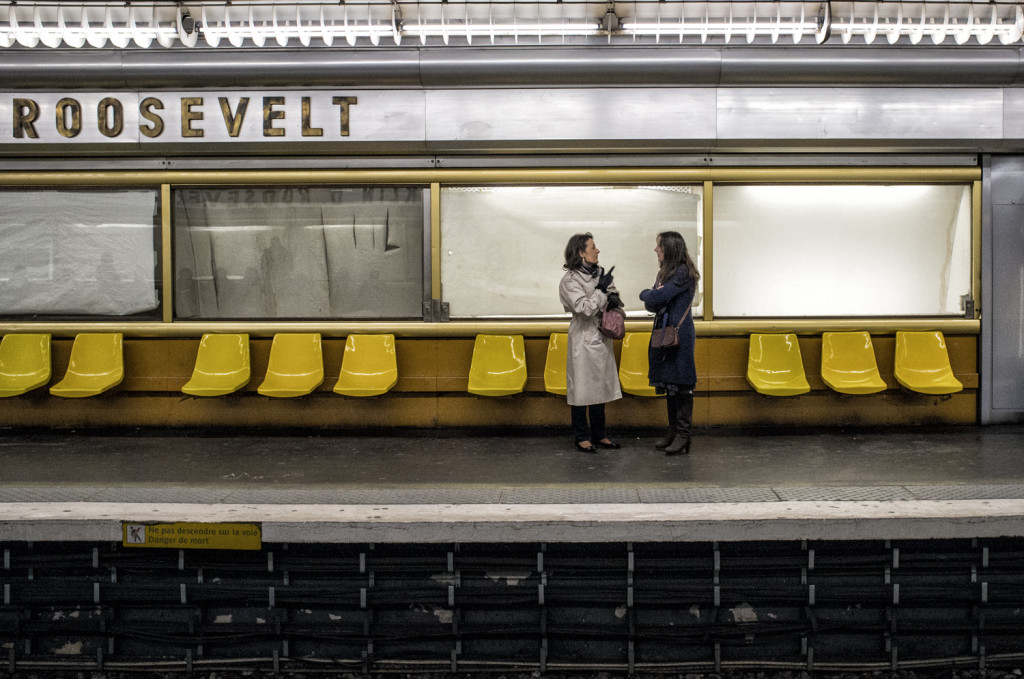
The one that really motivated me was a show called Decorum, Tapis et Tapisserie d’Artistes (rugs and tapestries) by contemporary artists, including some surprising names (Le Corbusier and Francis Bacon), some expected names (Sonya Delauney) and even a familiar Californian, Kay Sekimachi.
There were some delightful works, such as that of another contemporary Californian, Pae White, using digital techniques in her work. She was represented by a huge tapestry which was just amazing, curls of smoke billowing across the textile. The other two shows were interesting as well, completely new names for us, a 20th century abstract artist based in Paris, Serge Poliakoff, and a contemporary Chinese artist, Zeng Fanzhi.
The museum’s closing at 6 pm put us outside just in time for the Eiffel Tower light show, from one of the best vantages across the river.  After Steve spent his back up battery, we headed back along the Seine to meet up with our artist friend, Milène Guermont, who works with “polysensual” concrete, often incorporating aural and lighting elements in her sculptural and architectural installation works. We met at a tiny gallery on rue de Seine, and headed down the street for a drink and catch up at an atmospheric bar, La Palette, decorated with artist’s palettes, painted tiles and many paintings mounted overhead.
After Steve spent his back up battery, we headed back along the Seine to meet up with our artist friend, Milène Guermont, who works with “polysensual” concrete, often incorporating aural and lighting elements in her sculptural and architectural installation works. We met at a tiny gallery on rue de Seine, and headed down the street for a drink and catch up at an atmospheric bar, La Palette, decorated with artist’s palettes, painted tiles and many paintings mounted overhead.
Steve and decided on the fly to catch dinner in our old “hood,” rue Christine, where we once stayed a few years back with MOPA. We chose Chez Fernand from among the 3 options on this tiny street. Ensconced in the window seat, we dined on a salad of haricots vertes, followed by beef bourgignon for Steve and scallops with leeks for me. We had a nice meal. We didn’t have enough room for the tarte tatin but it looked good. We thought the restaurant “correct” in every respect and wouldn’t hesitate to eat here again if in the neighborhood, but wouldn’t necessarily consider it a “destination” restaurant. In fairness, we really prefer more contemporary, lighter-style to traditional French cuisine.
Our final day was dedicated to flaneuring, wandering, not quite aimlessly, but less directed. Patricia met us at Rose Bakery in the north part of this ‘hood. My lunch of celery root soup sprinkled with chestnut bits was warming, helping offset the first day that really felt like winter. Afterwards, we headed to the river, trying to catch a photography gallery open (Galerie Agathe Gaillard). It was supposed to open at 2 pm, but we came and went several times, without success. There are a number of charming shops in the surrounding streets, including two Japanophile stores, Kimonoya and Ikat, a store devoted to high end paper objects, and contemporary ceramics, La Célestine. Eventually, we decided to head to our planned destination, the Bibliothèque National (one of several) in the 1st arrondissement, for the street photography show of Anders Petersen. After deciding to walk rather than jump into the Metro, Pat and I headed into the giant store, BHV, to use the restroom. Despite the size of the store, there is only one set of restrooms, in a far corner on a high floor. Steve decided we had ditched him and gone shopping when we didn’t materialize after 20 minutes or so, so he took off and wasn’t to be found when we eventually returned. I turned on my phone to find his text confirming he had taken off, so we headed on, taking a spin through one of my perenniel favorite Paris spaces, the reconstructed, light filled studio of Constantin Brancusi, the Romanian sculpture who lived and work in Paris for decades.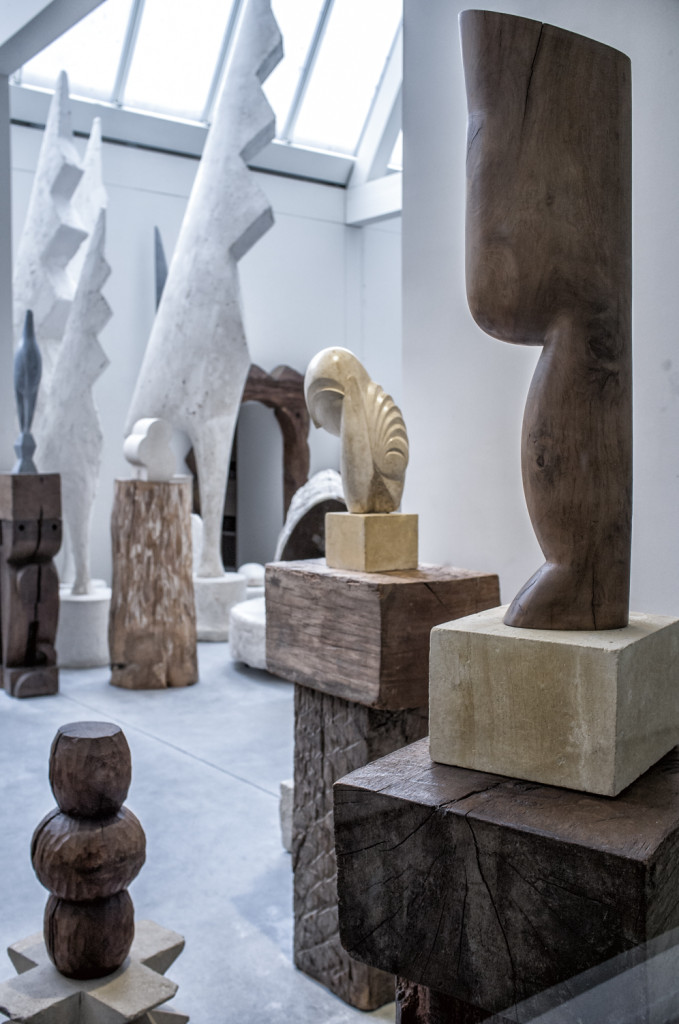
En route to the Bibliothèque, we passed through the gorgeous Galerie Vivienne. This is the most splendid of Paris’ restored covered passages, shopping arcades reflecting the elegance of the Belle Epoch.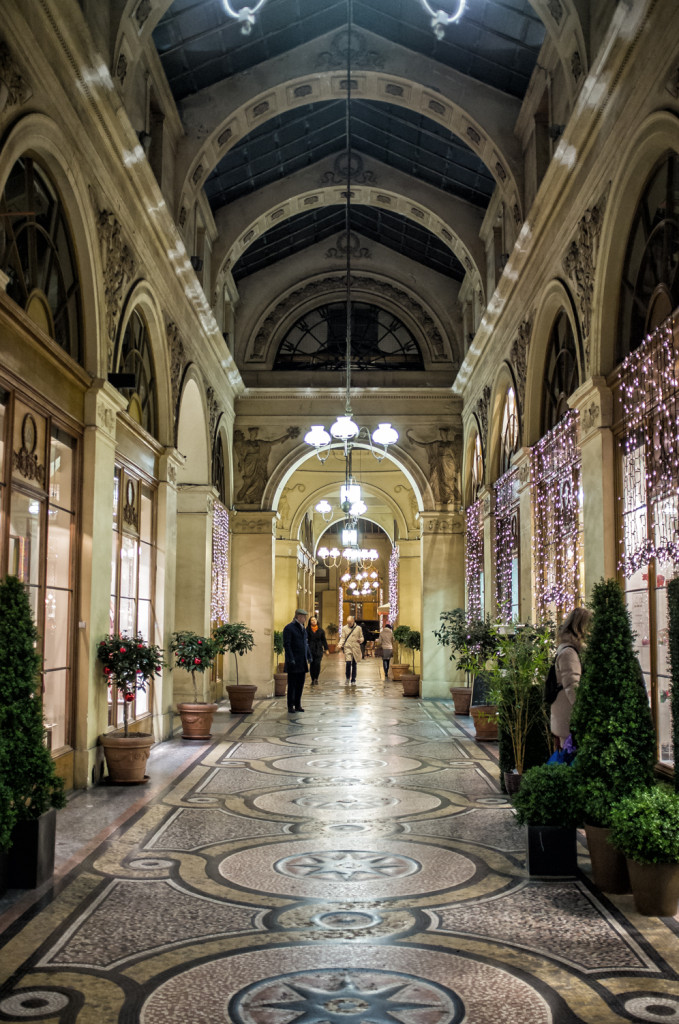
Anders Petersen has a decidedly darker vision than the genteel pleasures of the covered passages. He is Swedish, and his work had a gritty sensibility, reflecting some of his favored photographic haunts over the years: bars, a mental hospital, nursing home, as well as the denizens of the demi-monde. Interesting contrast to the more quirky and fantastical dark outlook of David Lynch.
The Biblioteque itself has a beautiful reading room, which is off-limits, unless one has an approved research interest.
There was just enough time on the way back to dinner through the arcade to check out les soldes at Cambrures, an Italian shoe store Clarissa and I had discovered a few trips ago. Grey patent leather boots by Dyva from this store had been a footware mainstay of this trip. Sporty black shoe cousins were waiting for me, en soldes bien sûr, possibly my best walking shoes ever.
Margie was the first to arrive for our rendezvous outside of Frenchie bar à vin, huddled under an umbrella with a few other early arrivals. They open at 7 pm, and don’t take reservations, so arriving a few minutes before 7 pm assures one of having a table.
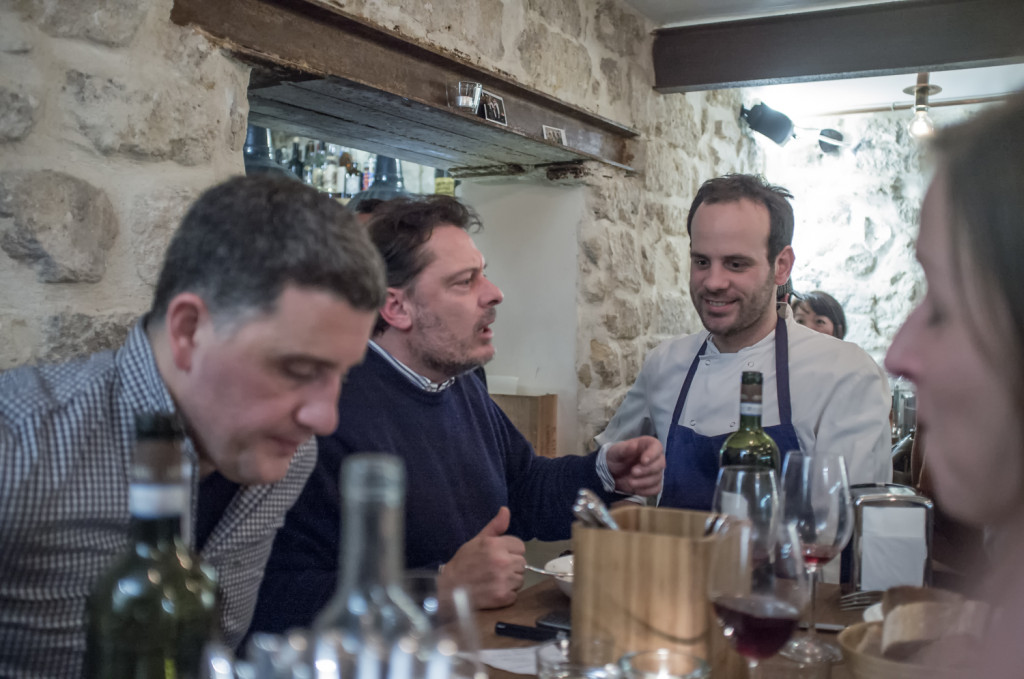
Frenchie himself, Gregory Marchand, chatting with a patron at a communal table in Frenchie bar à vin
We shared butternut squash stuffed pasta, house-made country-style pâté, black scallops with shavings of black truffle, burratta, papardelle with boar sauce, and a bottle of Loire Valley white. We didn’t have room for dessert, regretfully, but a glass of cidre glace from Canada, (a delight I’ve enjoyed only once before, last summer in Whistler) was the perfect final sweet note to a wonderful meal and sojourn in the City of (De)Lights.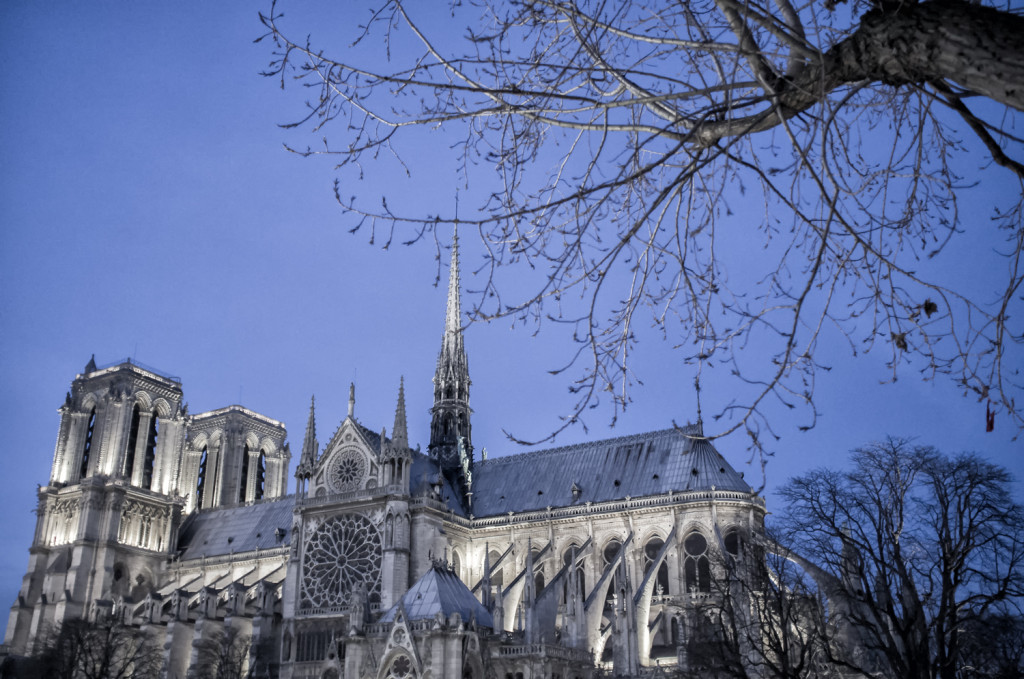
January in Paris?
Yes, Christmas decorations are still up, the weather can be cold and wet, but there is so much to discover and do, and fewer people to share it with. Oui, je suis SOLDE!
-Marie
Some links for future reference:
Hôtel Relais Saint-Germaine et le comptoir, 9 carrefour de l’Odéon, 75006, www.hotel-relais-saint-germain.com (email: hotelrsg@wanadoo.fr)
La Célestine (Ceramique Contemporaine), 5 bis rue St Paul; 75004, www.lacelestine.fr


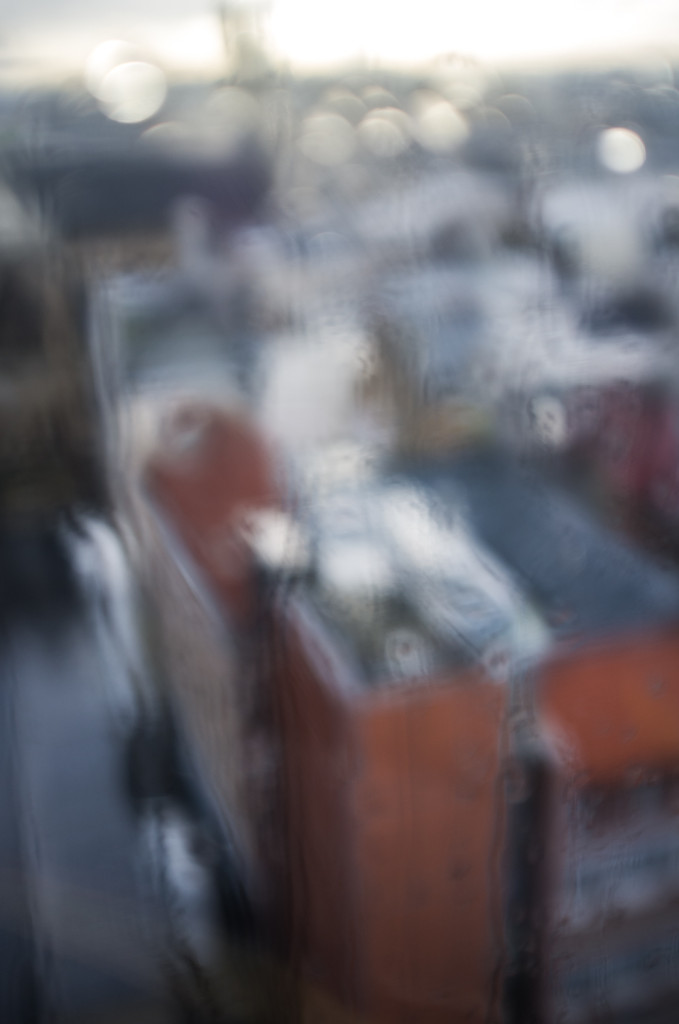


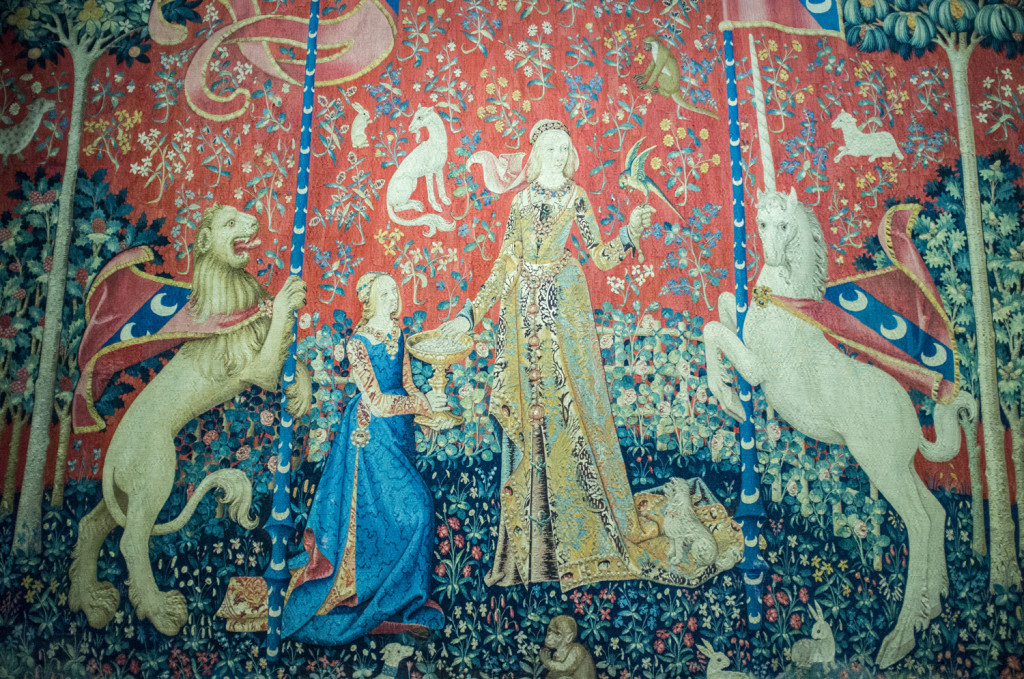
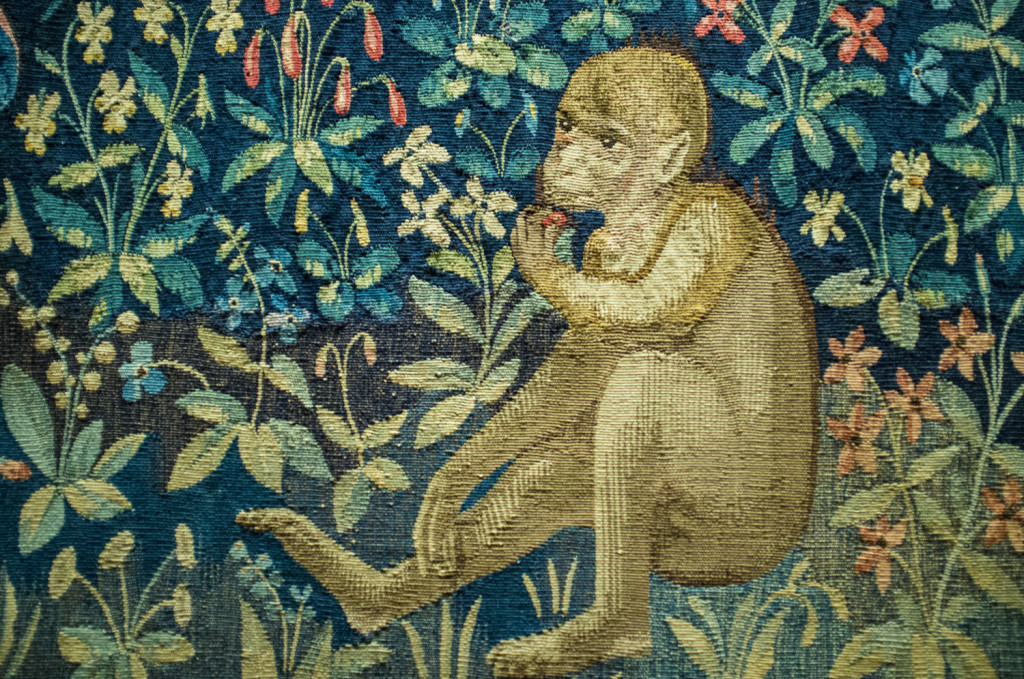
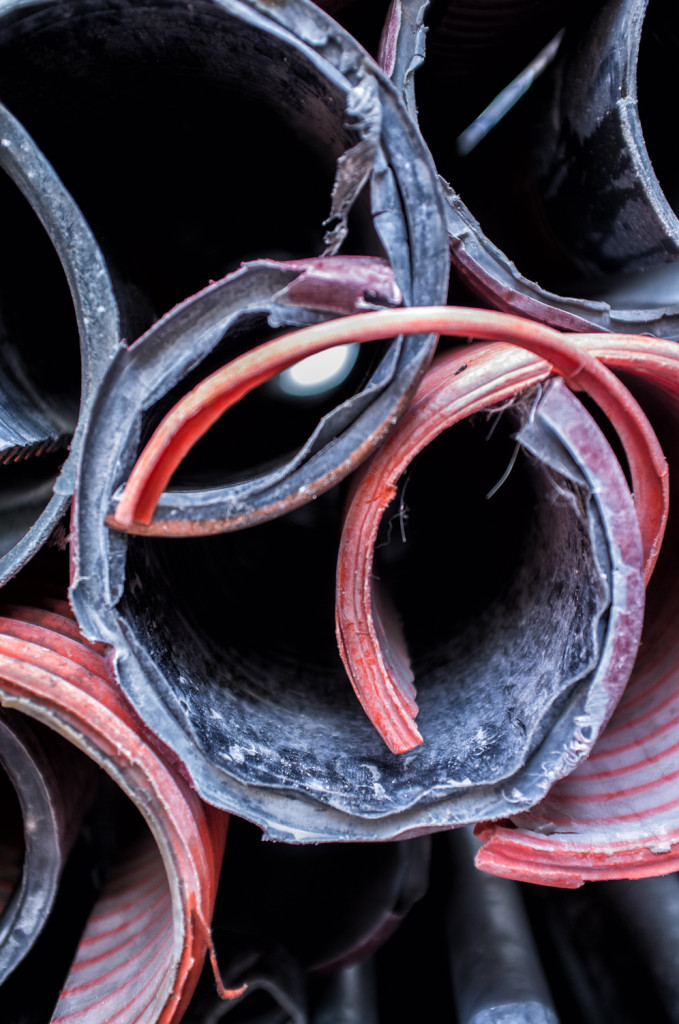

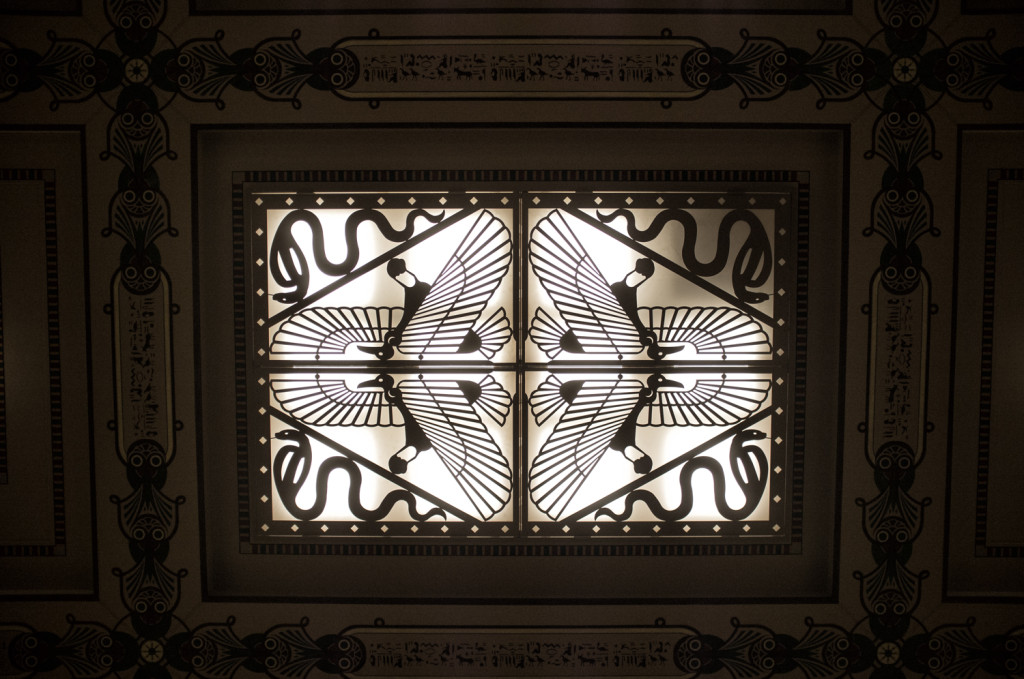
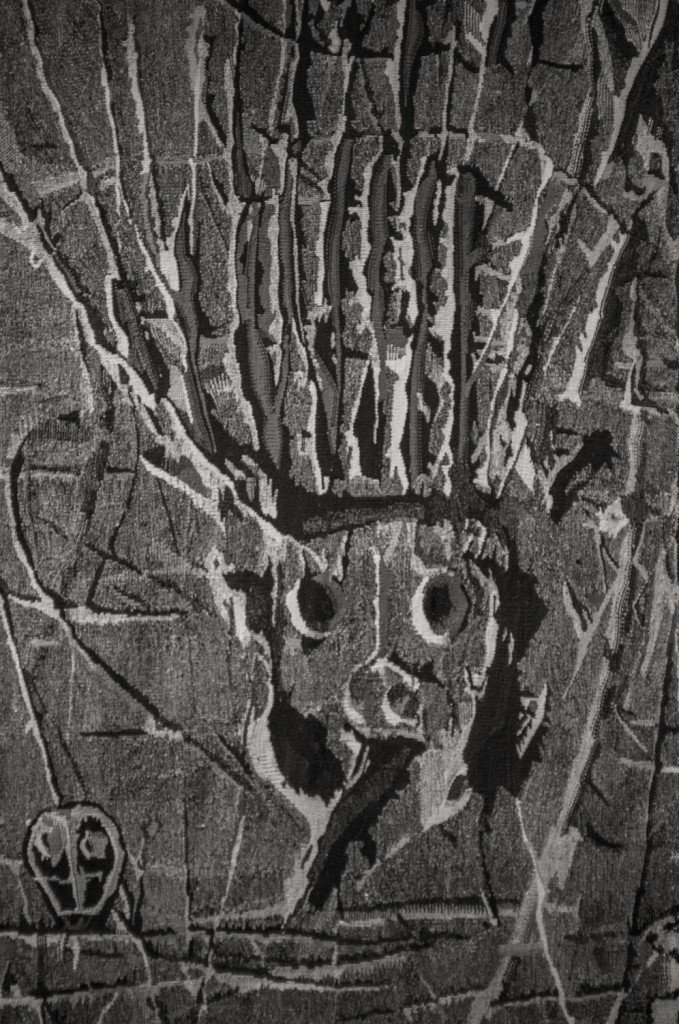
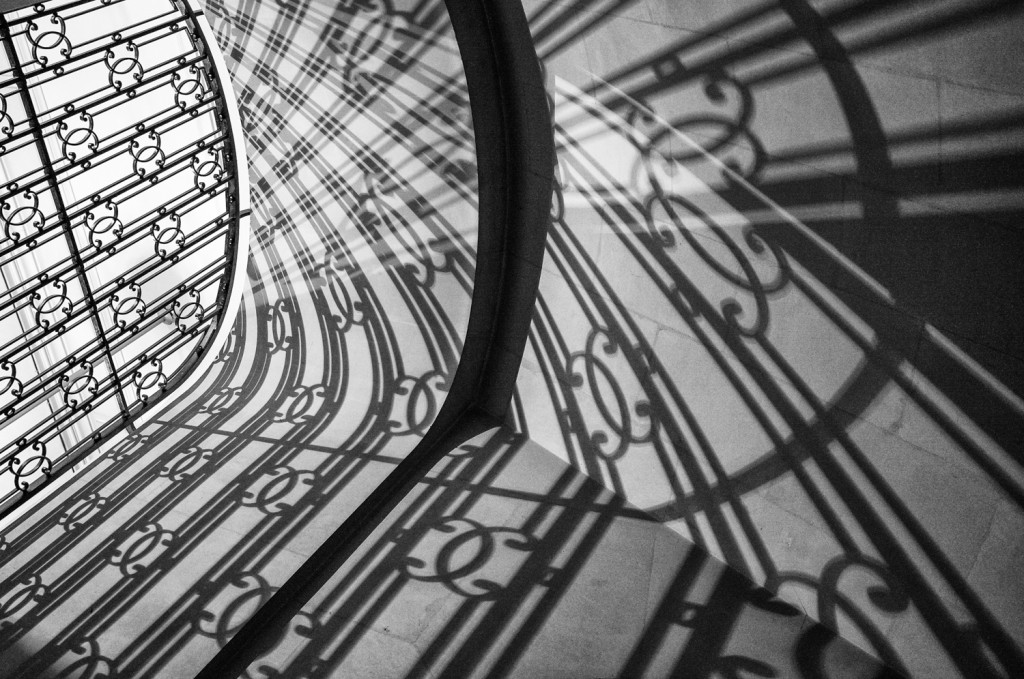

Beautiful work, Marie. So lucky to share these adventures with you! – steve
Et moi aussi! Tu es le meilleur compagnon pour voyager et la vie! Je t’aime -Marie
Great photos, commentary, spirit of discovery! If I didn’t already live in Paris, I would have to move here. Thanks for sharing your time and creativity. Keep coming back to Paris, but continue your exploration and documentation of new places.
Merci beaucoup et merci encore pour ton amitié, et l’encouragement! C’était un vrai plasir de te voir encore! Thanks for sharing your Paris with us! I look forward to your posts from Japan!-Marie
Great blog! Fun to read and tempting me to go try some of your haunts! I’d love to pal around with you on one of these trips here.
hugs
Jann
I would too! Did we overlap there and not even realize it? I saw a bookclub related email which led me to think you were going to be in Paris after our departure. Dommage!-Marie